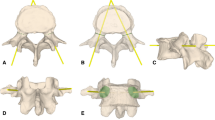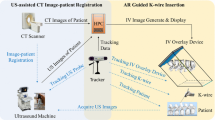Abstract
Purpose
Augmented reality has potential to enhance surgical navigation and visualization. We determined whether head-mounted display augmented reality (HMD-AR) with superimposed computed tomography (CT) data could allow the wearer to percutaneously guide pedicle screw placement in an opaque lumbar model with no real-time fluoroscopic guidance.
Methods
CT imaging was obtained of a phantom composed of L1–L3 Sawbones vertebrae in opaque silicone. Preprocedural planning was performed by creating virtual trajectories of appropriate angle and depth for ideal approach into the pedicle, and these data were integrated into the Microsoft HoloLens using the Novarad OpenSight application allowing the user to view the virtual trajectory guides and CT images superimposed on the phantom in two and three dimensions. Spinal needles were inserted following the virtual trajectories to the point of contact with bone. Repeat CT revealed actual needle trajectory, allowing comparison with the ideal preprocedural paths.
Results
Registration of AR to phantom showed a roughly circular deviation with maximum average radius of 2.5 mm. Users took an average of 200 s to place a needle. Extrapolation of needle trajectory into the pedicle showed that of 36 needles placed, 35 (97%) would have remained within the pedicles. Needles placed approximated a mean distance of 4.69 mm in the mediolateral direction and 4.48 mm in the craniocaudal direction from pedicle bone edge.
Conclusion
To our knowledge, this is the first peer-reviewed report and evaluation of HMD-AR with superimposed 3D guidance utilizing CT for spinal pedicle guide placement for the purpose of cannulation without the use of fluoroscopy.





Similar content being viewed by others
References
Thakkar SC, Thakkar RS, Sirisreetreerux N, Carrino JA, Shafiq B, Hasenboehler EA (2017) 2D versus 3D fluoroscopy-based navigation in posterior pelvic fixation: review of the literature on current technology. Int J Comput Assist Radiol Surg 12(1):69–76
Wolf MK, Rostetter C, Stadlinger B, Locher M, Damerau G (2015) Preoperative 3D imaging in maxillary sinus: brief review of the literature and case report. Quintessence Int 46(7):627–631
Adamczak SE, Bova FJ, Hoh DJ (2017) Intraoperative 3D computed tomography: spine surgery. Neurosurg Clin N Am 28(4):585–594
Javan R, Zeman MN (2017) A prototype educational model for hepatobiliary interventions: unveiling the role of graphic designers in medical 3D printing. J Digit Imaging 23(9):1183–1189
Wilcox B, Mobbs RJ, Wu AM, Phan K (2017) Systematic review of 3D printing in spinal surgery: the current state of play. J Spine Surg 3(3):433–443
Ballard DH, Trace AP, Ali S, Hodgdon T, Zygmont ME, DeBenedectis CM, Smith SE, Richardson ML, Patel MJ, Decker SJ, Lenchik L (2018) Clinical applications of 3D printing: primer for radiologists. Acad Radiol 25(1):52–65
Bourgeois A, Faulkner A, Bradley YC, Pasciak AS, Barlow PB, Gash JR, Reid WS (2015) Improved accuracy of minimally invasive transpedicular screw placement in the lumbar spine with 3-dimensional stereotactic image guidance: a comparative meta-analysis. Clin Spine Surg 28(9):324–329
Simpfendörfer T, Baumhauer M, Müller M, Gutt CN, Meinzer HP, Rassweiler JJ, Guven S, Teber D (2011) Augmented reality visualization during laparoscopic radical prostatectomy. J Endourol 25(12):1841–1845
Faiella E, Frauenfelder G, Santucci D, Luppi G, Schena E, Beomonte ZB, Grasso RF (2017) Percutaneous low-dose CT-guided lung biopsy with an augmented reality navigation system: validation of the technique on 496 suspected lesions. Clin Imaging 49:101–105
Grasso RF, Faiella E, Luppi G, Schena E, Giurazza F, Del Vescovo R, D’Agostino F, Cazzato RL, Beomonte ZB (2013) Percutaneous lung biopsy: comparison between an augmented reality CT navigation system and standard CT-guided technique. Int J Comput Assist Radiol Surg 8(5):837–848
Lee SC, Fuerst B, Tateno K, Johnson A, Fotouhi J, Osgood G, Tombari F, Navab N (2017) Multi-modal imaging, model-based tracking, and mixed reality visualisation for orthopaedic surgery. Healthc Technol Lett 4(5):168–173
Terander AE, Nachabe R, Skulason H, Pedersen K, Söderman M, Racadio J, Babic D, Gerdhem P, Edström E (2017) Feasibility and accuracy of thoracolumbar minimally invasive pedicle screw placement with augmented reality navigation technology. Spine J. https://doi.org/10.1097/brs.0000000000002502
Pfandler M, Lazarovici M, Stefan P, Wucherer P, Weigl M (2017) Virtual reality-based simulators for spine surgery: a systematic review. Spine J 17(9):1352–1363
Léger E, Drouin S, Collins DL, Popa T, Kersten-Oertel M (2017) Quantifying attention shifts in augmented reality image-guided neurosurgery. Healthc Technol Lett 4(5):188–192
Kosterhon M, Gutenberg A, Kantelhardtt SR, Archavlis E, Giese A (2017) Navigation and image injection for control of bone removal and osteotomy planes in spine surgery. Oper Neurosurg 13(2):297–304
Singla R, Edgcumbe P, Pratt P, Nguan C, Rohling R (2017) Intra-operative ultrasound-based augmented reality guidance for laparoscopic surgery. Healthc Technol Lett 4(5):204–209
Sauer IM, Queisner M, Tang P, Moosburner S, Hoepfner O, Horner R, Lohmann R, Pratschke J (2017) Mixed reality in visceral surgery: development of a suitable workflow and evaluation of intraoperative use-cases. Ann Surg 266(5):706–712
Galvis V, Berrospi RD, Arias JD, Tello A, Bernal JC (2017) Heads up Descemet membrane endothelial keratoplasty performed using a 3D visualization system. J Surg Case Rep 11(1):1–4
Chu Y, Yang J, Ma S, Ai D, Li W, Song H, Li L, Chen D, Chen L, Wang Y (2017) Registration and fusion quantification of augmented reality based nasal endoscopic surgery. Med Image Anal 42:241–256
Scolozzi P, Bijlenga P (2017) Removal of recurrent intraorbital tumour using a system of augmented reality. Br J Oral Maxillofac Surg 55(9):962–964
Aydin A, Raison N, Khan MS, Dasgupta P, Ahmed K (2016) Simulation-based training and assessment in urological surgery. Nat Rev Urol 13(9):503–519
Kim Y, Kim H, Kim YO (2017) Virtual reality and augmented reality in plastic surgery: a review. Arch Plast Surg 44(3):179–187
Vávra P, Roman J, Zonča P, Ihnát P, Němec M, Kumar J, Habib N, El-Gendi A (2017) Recent development of augmented reality in surgery: a review. J Healthc Eng. https://doi.org/10.1155/2017/4574172
Gasco J, Patel A, Ortega-Barnett J, Branch D, Desai S, Kuo YF, Luciano C, Rizzi S, Kania P, Matuyauskas M, Banerjee P, Roitberg BZ (2014) Virtual reality spine surgery simulation: an empirical study of its usefulness. Neurol Res 36(11):968–973
Johnston MJ, Paige JT, Aggarwal R, Stefanidis D, Tsuda S, Khajuria A, Arora S, Association for Surgical Education Simulation Committee (2016) An overview of research priorities in surgical simulation: what the literature shows has been achieved during the 21st century and what remains. Am J Surg 211(1):214–225
Dawe SR, Pena GN, Windsor JA, Broeders JA, Cregan PC, Hewett PJ, Maddern GJ (2014) Systematic review of skills transfer after surgical simulation-based training. Br J Surg 101(9):1063–1076
Pulijala Y, Ma M, Pears M, Peebles D, Ayoub A (2017) Effectiveness of immersive virtual reality in surgical training—a randomized control trial. J Oral Maxillofac Surg. https://doi.org/10.1016/j.joms.2017.10.002
Barsom EZ, Graafland M, Schijven MP (2016) Systematic review on the effectiveness of augmented reality applications in medical training. Surg Endosc 30(10):4174–4183
Kwon OH, Muelder C, Lee K, Ma KL (2017) A study of layout, rendering, and interaction methods for immersive graph visualization. IEEE Trans Vis Comput Graphics 22(7):1802–1815
Qian L, Barthel A, Johnson A, Osgood G, Kazanzides P, Navab N, Fuerst B (2017) Comparison of optical see-through head-mounted displays for surgical interventions with object-anchored 2D-display. Int J Comput Assist Radiol Surg 12(6):901–910
Nan C, Pradosh K, Viktor G (2017) Augmented reality with Microsoft HoloLens holograms for near infrared fluorescence based image guided surgery. Proc SPIE. https://doi.org/10.1117/12.2251625
Kuhlemann I, Kleemann M, Jauer P, Schweikard A, Ernst F (2017) Towards X-ray free endovascular interventions—using HoloLens for on-line holographic visualisation. Healthc Technol Lett 4(5):184–187
Bederman SS, Le VH, Pahlavan S (2016) An approach to lumbar revision spine surgery in adults. J Am Acad Orthop Surg 24(7):433–442
Chandra RV, Maingard J, Asadi H, Slater LA, Mazwi TL, Marcia S, Barr J, Hirsch JA (2017) Vertebroplasty and kyphoplasty for osteoporotic vertebral fractures: what are the latest data? Am J Neuroradiol. https://doi.org/10.3174/ajnr.a5458
Chan A, Parent E, Narvacan K, San C, Lou E (2017) Intraoperative image guidance compared with free-hand methods in adolescent idiopathic scoliosis posterior spinal surgery: a systematic review on screw-related complications and breach rates. Spine J 17(9):1215–1229
Chaudhari A, Lakhani K, Deulkar K (2015) Transforming the world using holograms. Int. J Comput Appl Eng Sci 130(1):30–32
Evans G, Miller J, Pena MI, MacAllister A, Winer E (2017) Evaluating the Microsoft HoloLens through an augmented reality assembly application. Proc SPIE. https://doi.org/10.1117/12.2262626
Matsukawa K, Yato Y (2017) Lumbar pedicle screw fixation with cortical bone trajectory: a review from anatomical and biomechanical standpoints. Spine Surg Relat Res 1(4):164–173
Gabbita A, Usman MM, Kishan A, Varadaraju DN, Patil SG, Hosmath AV (2016) Pedicle screw placement in the thoracic and lumbar spine by the c-arm guided navigation and the free hand method: a technical and outcome analysis. J Spine Surg 3(3):90–95
Bernard TN, Seibert CE (1992) Pedicle diameter determined by computed tomography. Its relevance to pedicle screw fixation in the lumbar spine. Spine J 17(6):160–163
Lai DM, Shih YT, Chen YH, Chien A, Wang JL (2017) Effect of pedicle screw diameter on screw fixation efficacy in human osteoporotic thoracic vertebrae. J Biomech. https://doi.org/10.1016/j.jbiomech.2017.10.009
Theologis AA, Burch S, Pekmezci M (2016) Placement of iliosacral screws using 3D image-guided (O-Arm) technology and Stealth Navigation: comparison with traditional fluoroscopy. Bone Joint J 98-B(5):696–702
Spitz SM, Sandhu FA, Voyadzis JM (2015) Percutaneous “K-wireless” pedicle screw fixation technique: an evaluation of the initial experience of 100 screws with assessment of accuracy, radiation exposure, and procedure time. J Neurosurg Spine 22(4):422–431
Wray S, Mimran R, Vadapalli S, Shetve SS, McGilvray KC, Puttlitz CM (2015) Pedicle screw placement in the lumbar spine: effect of trajectory and screw design on acute biomechanical purchase. J Neurosurg Spine 22(5):503–510
Chung KJ, Sug SW, Desai S, Song HR (2008) Ideal entry point for the thoracic pedicle screw during the free hand technique. Int Orthop 32(5):657–662
Zindrick MR, Wiltse LL, Doornik A, Widell EH, Knight GW, Patwardhan AG, Thomas JC, Rothman SL, Fields BT (1987) Analysis of the morphometric characteristics of the thoracic and lumbar pedicles. Spine 12(2):160–166
Labadie RF, Davis BM, Fitzpatrick JM (2005) Image-guided surgery: what is the accuracy? Curr Opin Otolaryngol Head Neck Surg 13(1):27–31
Afshari E, Rostami M, Farahmand F (2017) Review on different experimental techniques developed for recording force-deformation behaviour of soft tissues; with a view to surgery simulation applications. J Med Eng Technol 41(4):257–274
Tonutti M, Gras G, Yang GZ (2017) A machine learning approach for real-time modelling of tissue deformation in image-guided neurosurgery. Artif Intell Med 80:39–47
Pan IW, Harris DA, Luerssen TG, Lam SK (2017) Comparative effectiveness of surgical treatments for pediatric hydrocephalus. Neurosurgery. https://doi.org/10.1093/neuros/nyx440
Hervey-Jumper SL, Berger MS (2016) Maximizing safe resection of low- and high-grade glioma. J Neurooncol 130(2):269–282
Jensen ME, McGraw JK, Cardella JF, Hirsch JA (2009) Position statement on percutaneous vertebral augmentation: a consensus statement developed by the American Society of Interventional and Therapeutic Neuroradiology, Society of Interventional Radiology, American Association of Neurological Surgeons/Congress of Neurological Surgeons, and American Society of Spine Radiology. J Vasc Interv Radiol 20(7):326–331
Alaraj A, Charbel FT, Birk D, Tobin M, Luciano C, Banerjee PP, Rizzi S, Sorenson J, Foley K, Slavin K, Roitberg B (2013) Role of cranial and spinal virtual and augmented reality simulation using immersive touch modules in neurosurgical training. Neurosurgery 72(1):115–123
Acknowledgements
We would like to thank Novarad for allowing us to use the Novarad PACS software and the OpenSight application to perform this research.
Author information
Authors and Affiliations
Corresponding author
Ethics declarations
Conflict of interest
Steve Cvetko is an employee of Novarad. The remaining authors declare that they have no conflict of interest.
Research involving human participants and/or animals
This article does not contain any studies with human participants or animals performed by any of the authors.
Informed consent
This article does not contain patient data.
Rights and permissions
About this article
Cite this article
Gibby, J.T., Swenson, S.A., Cvetko, S. et al. Head-mounted display augmented reality to guide pedicle screw placement utilizing computed tomography. Int J CARS 14, 525–535 (2019). https://doi.org/10.1007/s11548-018-1814-7
Received:
Accepted:
Published:
Issue Date:
DOI: https://doi.org/10.1007/s11548-018-1814-7




